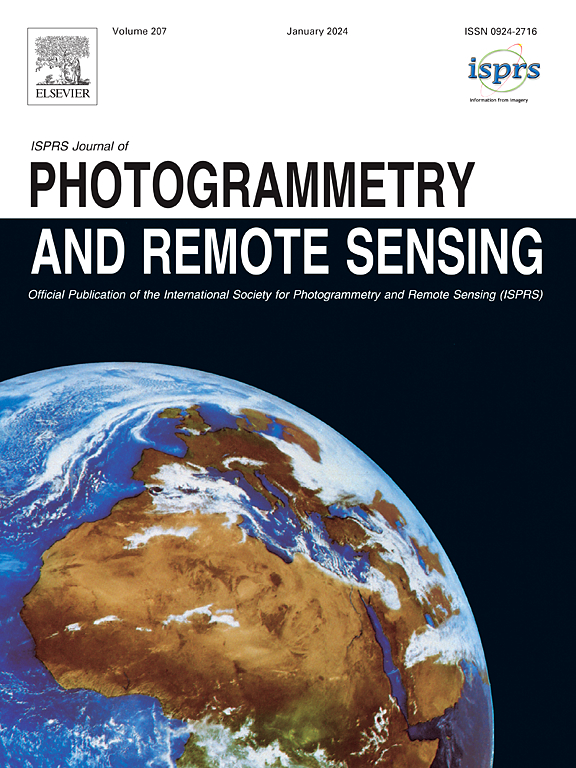Improving visual grounding in remote sensing images with adaptive modality guidance
IF 10.6
1区 地球科学
Q1 GEOGRAPHY, PHYSICAL
ISPRS Journal of Photogrammetry and Remote Sensing
Pub Date : 2025-04-01
DOI:10.1016/j.isprsjprs.2025.02.031
引用次数: 0
Abstract
This study explores the visual grounding (VG) task using data from remote sensing sensors, focusing on grounding phrases or prompts. We achieve this by employing masked feature encoding to create enriched, target-specific, and semantically aware visual representations. We aim to develop an efficient grounding architecture that uses language expressions as prompts for aerial images. Despite significant progress in phrase grounding within natural scenes, the vision community has yet to effectively translate these advancements to aerial imagery. This gap is mainly due to the lack of finely annotated remote sensing datasets and the substantial variation in the dimensional attributes of instances observed on Earth’s surface. We propose a novel framework, AMVG, for visual grounding, designed to enhance object localisation by leveraging multi-modal deformable attention encoding and adaptive decoding guided by language. In contrast to traditional methods that utilise region proposals or anchor-box-based predictions, our approach dynamically adapts attention to emphasise key spatial details and contextually relevant areas, enabling more accurate alignment of visual and textual features. Additionally, we propose a new training objective, Attention Alignment Loss (AAL), to address inconsistencies in attention allocation that can lead to suboptimal grounding accuracy. Experiments demonstrate that our method, Adaptive Modality-guided Visual Grounding (AMVG), significantly improves grounding accuracy compared to baseline methods, especially in challenging scenarios involving multiple textual and instance descriptions or ambiguous visual contexts. Our methodology outperforms recent methods, including MGVLF, CrossVG, VSMR, LPVA, and LQVG, achieving marginal improvements of 7.14%, 4.06%, 5.74%, 2.27%, and 3.35% in mean IoU, respectively. Similarly, for cumulative IoU, our approach surpasses MGVLF, VSMR, LPVA, and LQVG by 11.79%, 10.5%, 5.31%, and 3.14%, respectively. Similar trends are observed on the RSVG-HR and OPT-RSVG datasets, where AMVG demonstrates superior grounding accuracy in challenging scenarios involving complex textual prompts, ambiguous visual contexts, and diverse object attributes. These results reaffirm the effectiveness of our proposed method and its potential to address critical challenges in remote sensing VG tasks, setting a new benchmark in this domain. The full implementation of AMVG is publicly available https://github.com/Shabnamchoudhury/AMVG.git.
求助全文
约1分钟内获得全文
求助全文
来源期刊

ISPRS Journal of Photogrammetry and Remote Sensing
工程技术-成像科学与照相技术
CiteScore
21.00
自引率
6.30%
发文量
273
审稿时长
40 days
期刊介绍:
The ISPRS Journal of Photogrammetry and Remote Sensing (P&RS) serves as the official journal of the International Society for Photogrammetry and Remote Sensing (ISPRS). It acts as a platform for scientists and professionals worldwide who are involved in various disciplines that utilize photogrammetry, remote sensing, spatial information systems, computer vision, and related fields. The journal aims to facilitate communication and dissemination of advancements in these disciplines, while also acting as a comprehensive source of reference and archive.
P&RS endeavors to publish high-quality, peer-reviewed research papers that are preferably original and have not been published before. These papers can cover scientific/research, technological development, or application/practical aspects. Additionally, the journal welcomes papers that are based on presentations from ISPRS meetings, as long as they are considered significant contributions to the aforementioned fields.
In particular, P&RS encourages the submission of papers that are of broad scientific interest, showcase innovative applications (especially in emerging fields), have an interdisciplinary focus, discuss topics that have received limited attention in P&RS or related journals, or explore new directions in scientific or professional realms. It is preferred that theoretical papers include practical applications, while papers focusing on systems and applications should include a theoretical background.
 求助内容:
求助内容: 应助结果提醒方式:
应助结果提醒方式:


